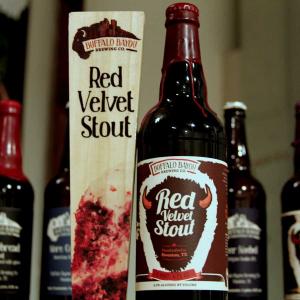As the old Texas saying goes, if you don’t like the weather, just wait a minute. Winter’s grip on the state may be loosening—then tightening, then loosening, then tightening—but it’s not too late to enjoy some seasonal stouts and porters from our craft breweries.
These darker brews are typically distinguished by their strong notes of coffee or chocolate and roasted aromatics, flavor profiles that pair well with cool weather. So what’s the difference between stouts and porters? The old rule is that stout recipes include roasted barley while porters tend to have a thinner mouth-feel, but modern-day brewers seem to disregard any strict guidelines and instead present their highly subjective, cross-pollinated specialties to drinkers. The one requirement everyone can agree? Stouts and porters should be served in 6-ounce snifters at temperatures of 45 to 50 degrees, so that all the nuanced flavors can emerge.
 Saint Arnold’s Winter Stout
Saint Arnold’s Winter Stout
5.5 % alcohol by volume (ABV)
36 international bitterness units
Now in its eighth iteration, this award-winning brew from Houston’s oldest craft brewery has been around since 2007. This ale is a good starter stout for people who are wading into dark beer territory for the first time. More drinkable than a Guinness and favoring a slightly flowery profile, Saint Arnold’s Winter Stout is smooth drinking. When we poured from the bottle, the black-hued brew appeared to have a thinner texture and no sour notes hit our nose. The tan head quickly disappeared, and the first sip had an appreciably subtle mouth-feel and bright flavor. This stout has admirable complexity, a result of the specialty malts and roast barley found in this recipe concocted by homebrewer-turned-beer lobbyist Charles Vallhonrat of the Texas Craft Brewers Guild. The lasting impression was a creamy, chocolaty, bittersweet brew that won’t fill you up. But get it before it disappears from shelves and taps in March, because it won’t make an appearance again until this December.
 Buffalo Bayou Red Velvet Stout
Buffalo Bayou Red Velvet Stout
6.2 % ABV
25 IBU
There is something to be said for breaking free from hidebound traditions—at least when it comes to brewing. To wit, my drinking partner is not a fan of red velvet cake, but she was happy to join me on the road less taken when I opened a 22-ounce bottle of the January 2015 Red Velvet Stout. The concoction from three-year-old Buffalo Bayou Brewing Co. represents one of the Houston brewery’s creative “secessionist” beers, which are crafted to challenge assumptions about conventional approached to brewing. This one uses ingredients suggested by H-town baker Rebecca Masson, and pastry flavors are apparent in the chocolate and vanilla notes that are balanced by what tastes like a touch of jam. The dark brown ale has a medium body, beige head, and strong legs. It also has a slightly dry mouth feel. Marketed as a dessert drink, the semi-sweet Red Velvet is a perfect valentine for the beer-lover on your list.
Karbach Bourbon Barrel HellFighter
11 % ABV
85 IBU
Known as BBH, this boozy Imperial Porter has emerged from Karbach’s barrel-aged F.U.N. series, which began in 2012 and is now the flagship of the Houston brewery’s bourbon-aged ales (other F.U.N. beers have been aged in wine casks). Karbach buys old whiskey barrels from Four Roses, Maker’s Mark, and other distillers, and then ages their beers in the casks for at least five months. The BBH, a bold-yet-complex beer that clearly owes a debt to English porters, carries an unmistakable whiff of bourbon, while dark-roasted malts contribute to a midnight-black pour and toffee-like beige head. A bit sticky in the mouth, the lasting caramel notes help the audacious BBH go down smooth. We definitely look forward to the next bourbon-aged beers that will be released throughout 2015.
Real Ale Brewer’s Cut Oyster Stout
6.5 % ABV
35 IBU
We were tipped to this ocean-tinged limited release from Blanco-based Real Ale before last Christmas by Justin Chamberlin, the beverage manager of Dai Due in Austin, and we were recently finally able to track down a case. Real Ale dumps batches of Gulf Coast bivalves right in the brewer’s kettle, creating a very distinctive winter ale that has a briny nose and slightly salty finish. Roasted malts combat any lingering bitterness in the recipe, though, making for a dark pour. Not so viscous as sweeter, more alcoholic beers on this list, the pale, subtle head testified to the low levels of carbonation (from the six-pack we tried, at least). Though Chamberlin suggested pairing it with a beef rib roast, we enjoyed this fine-drinking concoction on its own. It’s a great way to get primed for the beach while we wait for summer.





